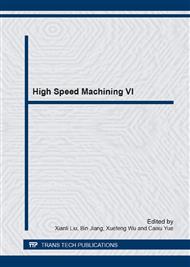p.385
p.390
p.394
p.398
p.402
p.408
p.417
p.424
p.430
Numerical Modeling of Minimum Uncut Chip Thickness for Micromachining with Different Work Materials
Abstract:
The determination of the minimum uncut chip thickness is essential in micro machining in order to achieve desired surface integrity and accuracy. The parameters being considered in determination the minimum uncut chip thickness include the cutting tool geometry, workpiece material, cutting parameters and so on. In this paper, five different materials including OFHC Copper, Al 7050, AISI 4340, Ti-6Al-4V and IN 718 with unequal materials’ properties were investigated to find materials parameters’ effect on the minimum uncut chip thickness. An Arbitrary Lagrangian Eulerian (ALE)-based numerical modeling is proposed to determine the minimum uncut chip thickness for the five different materials by changing depth-of-cut. The Johnson-Cook (J-C) constitutive model is employed to describe the work material behavior. Results show that the flow stress of different materials has significant effect on the minimum uncut chip thickness.
Info:
Periodical:
Pages:
402-407
Citation:
Online since:
July 2014
Authors:
Price:
Сopyright:
© 2014 Trans Tech Publications Ltd. All Rights Reserved
Share:
Citation:


